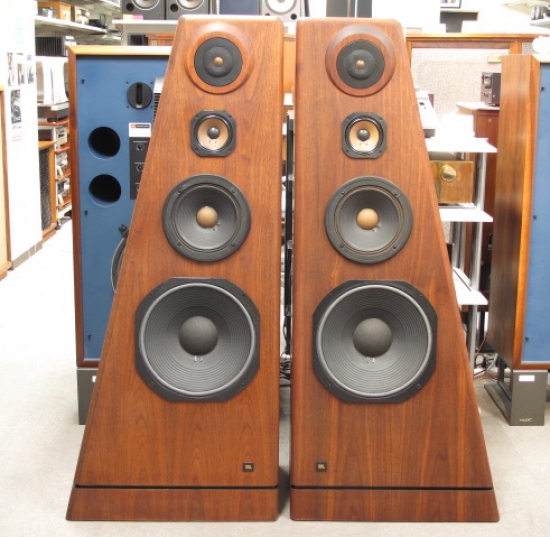JBL L250 Floor standing speakers
It's impossible not to be impressed by JBL's flagship loudspeaker-even before you hear it. One reason is that unlike most other audio products, the L-250 makes a strong visual statement. Styled as a truncated, asymmetrical pyramid, it stands almost four-and-a-half feet tall, and even with the grille cloth on, the tweeter remains exposed, looking like a large, golden eye. The impeccably crafted cabinet is available in several handsome wood finishes, and the grille comes in a variety of colors.
But there's more to the L-250's appearance than meets the eye: Form definitely follows function. For example, the virtual absence of parallel surfaces helps prevent resonance build-ups within the cabinet. The front baffle slopes backward slightly, to align the drivers' acoustical centers for minimum phase error, and tapers from bottom to top, to minimize the baffle area around each driver. JBL also rounds the cabinet edges, for minimum diffraction, and builds the speakers in mirror-image pairs, to promote accurate stereo imaging.
Each L-250 has four drivers configured in a near-vertical array: a 14-inch woofer near the bottom of the cabinet, an 8-inch lower-midrange driver, a 5-inch upper-midrange driver, and a 1-inch soft-dome tweeter at the top. All have cast frames (a JBL hallmark), and the two low-range drivers use JBL SFG (Symmetrical Field Geometry) magnet structures to keep distortion low at high drive levels. The woofer's output at very low frequencies is extended by a rear-firing port; the other drivers are isolated by their own subchambers to prevent undesirable acoustic interactions.
Crossovers are achieved with relatively gentle 6-dB-per-octave networks for low phase error and the smoothest possible transitions between drivers. JBL says that it selected the actual crossover points (400 Hz, 1.5 kHz, and 5 kHz) to assure low distortion, high power-handling capability, wide dispersion at all frequencies, and smooth frequency response both on and off axis. The company has also taken the unusual step of adding high-quality polypropylene or polystyrene bypass capacitors in parallel with the large electrolytics in the crossover circuits. The aim, according to JBL, is to improve the filter characteristics.
Amplifier connections are made to a pair of color-coded binding posts near the bottom of a large recess in the back panel. The remainder of the inset is occupied by three-position attenuators for each of the two midrange drivers and a four-position one for the tweeter. To assure unimpeded current transfer, JBL has elected to use screw-down bus bars instead of switches or potentiometers to select the degree of attenuation. This tends to discourage frequent readjustment, since changing the setting on one driver requires the removal and replacement of as many as six screws.
Our samples were delivered with the lower-midrange attenuator down one notch (nominally - 1.5 dB), the upper-midrange down one notch (-1 dB), and the tweeter down two notches (-2.5 dB). Diversified Science Laboratories ran response curves with the attenuators set as delivered and at their nominally flat positions. The former settings yielded smoother curves, so they were used for all further lab and listening tests. Per the manufacturer's recommendations, the L-250s were placed several feet from any walls with their grilles removed.
The speaker's sensitivity is moderately high, and as one would expect from the design, its power-handling ability is excellent. On 300-Hz tone bursts, the L-250 accepted the full output of DSL's amplifier-65 volts peak, equivalent to 27-1/4 dBW (530 watts) into 8 ohms. And total harmonic distortion (THD) is exceptionally low for a loudspeaker, even at very high levels. At a sound pressure level (SPL) of 100 dB, THD averages less than 1% over DSL's full test range (30 Hz to 10 kHz) and never rises above 5% at any frequency. At a much more moderate 85 dB SPL, distortion never makes it even to 1-1/4% and averages only about 1/4%.
Impedance varies smoothly with frequency, reaching a maximum of 21.5 ohms at 20 Hz and a minimum of 6.1 ohms at approximately 110 Hz. Given that, and the very safe average impedance of 9.6 ohms, we would have no compunction about driving a pair of L-250s in parallel with another set of speakers with any decent amplifier or receiver.
Response is within ±4 dB from approximately 30 Hz to 20 kHz on axis and to 16 kHz off axis. These figures do not adequately reflect, however, the overall smoothness of the curves. For example, from 30 Hz to 10 kHz, response is within approximately ±2.5 dB on axis and ±3.5 dB off. And the bass extension is clearly extraordinary-especially in light of the absence of any reinforcement from nearby walls.
This particular aspect of the JBL's performance has been driven home to us again and again during our listening tests: Its low-end reach, impact, and clarity are simply stunning. Overall, the sound is very smooth, with an occasional twinge of brightness on instruments such as triangles. The L-250 somehow manages to shelter comfortably under one roof a gutsy, upfront quality and a sensitive delicacy of reproduction seldom found together in such full flower in a single loudspeaker. It seems at home with any sort of material, able to maintain its clarity and composure at any volume-from the very soft to the very loud-in almost any frequency range.
Imaging is generally excellent, with good precision and lateral spread and a nice sense of depth and openness. There is some tendency to vertical stratification according to frequency, which occasionally causes high-pitched sounds to be localized somewhat above lower-frequency sounds. But this is fairly common among speakers having multiple drivers vertically distributed on a tall baffle and is rarely intrusive.
The evidence all points to JBL's engineering team having succeeded admirably in achieving its design goals. The result is not a speaker everyone will think beautiful, nor one many can afford. But the L-250 is a very fine reproducer of music, which for some is all that matters.




